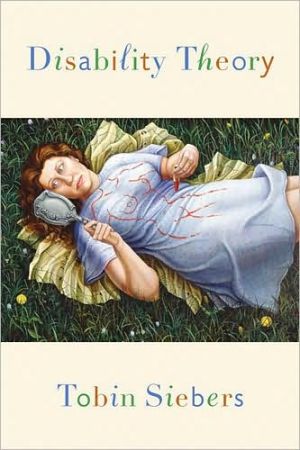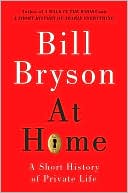Disability Theory
"Disability Theory is just the book we've been waiting for. Clear, cogent, compelling analyses of the tension between the 'social model' of disability and the material details of impairment; of identity politics and unstable identities; of capability rights and human interdependence; of disability and law, disability as masquerade, disability and sexuality, disability and democracy---they're all here, in beautifully crafted and intellectually startling essays. Disability Theory is a...
Search in google:
Boldly rethinks theoretical questions of the last thirty years from the vantage point of disability studies
Disability Theory\ \ By Tobin Siebers \ The University of Michigan Press\ Copyright © 2008 University of Michigan\ All right reserved.\ ISBN: 978-0-472-07039-8 \ \ \ Chapter One\ Introduction \ Disability Theory pursues three interlocking agendas. First, it makes an intervention from the perspective of disability studies in some of the major debates of the last thirty years in critical and cultural theory. My objective here is to address the two audiences at this convergence point: on the one hand, to demonstrate for critical and cultural theorists how disability studies transforms their basic assumptions about identity, ideology, politics, meaning, social injustice, and the body; on the other hand, to theorize the emerging field of disability studies by putting its core issues into contact with signal thinkers in the adjacent fields of cultural studies, literary theory, queer theory, gender studies, and critical race studies. Some of these debates include the possibility of ideology critique in the wake of increasingly powerful claims for the relation between ideology and unconscious thought; the authority of psychoanalysis in critical and cultural theory; the battle over the usefulness of identity politics; the impact of social construction theories in matters of gender, sexuality, and race; the assumptions underlying body theory as a field of study; the future of minority studies and whether one should be able to study what one is; thevalue of personal experience for theorizing social justice; the epistemology of passing in queer theory; the future alignment of the sex/gender system; and the ongoing struggle to theorize a viable model of human rights for the global world. The chapters to follow depend on the content specific to these great arguments and on the theorists who have best addressed them, but the goal remains in each case to use disability as a lever to elevate debate, not only by asking how the theories of our most influential critical and cultural thinkers advance disability studies but also by asking how disability theory might require these same thinkers to revise their own claims.\ Second, I offer an extended discussion of the broad means by which disability relates to representation itself. This second agenda may also be thought of as an intervention in the field of theory, although at the most general level, because the status of representation has been one of the most significant issues in critical and cultural theory since the emergence of structuralism in the 1960s. The structuralists and their heirs embrace language as the dominant model for theorizing representation, interpreting nearly all symbolic behavior in strictly linguistic terms. Two consequences of this so-called linguistic turn concern disability studies. First, because linguistic structuralism tends to view language as the agent and never the object of representation, the body, whether able or disabled, figures as a language effect rather than as a causal agent, excluding embodiment from the representational process almost entirely. As Jean-Luc Nancy puts it, in emblematic fashion, there is "no such thing as the body. There is no body" (207). Disability Theory echoes recent calls by Linda Martín Alcoff (2006), Donna Haraway, and N. Katherine Hayles to take the mimetic powers of embodiment seriously. Disabled bodies provide a particularly strong example of embodiment as mimesis because they resist standard ideas about the body and push back when confronted by language that would try to misrepresent their realism. Second, theorists influenced by the linguistic turn infrequently extend the theory of representation from mimesis properly speaking to political representation. This lack of flexibility has made it difficult to critique ideology within mimetic theory, to push discourse theory in the direction of a broader consideration of the real as a domain in which words and things exist in relations of verifiable reciprocity, and to account for social and political representation beyond narrow ideas of social constructionism. A focus on the disabled body encourages a more generous theory of representation that reaches from gestures and emotions to language and political representation. It also opens the possibility of classifying identity as an embodied representational category, thereby inserting the body into debates about identity politics.\ Third, this book theorizes disability as a minority identity, one whose particular characteristics contribute to the advancement of minority studies in general. While seen historically as a matter for medical intervention, disability has been described more recently in disability studies as a minority identity that must be addressed not as personal misfortune or individual defect but as the product of a disabling social and built environment. Tired of discrimination and claiming disability as a positive identity, people with disabilities insist on the pertinence of disability to the human condition, on the value of disability as a form of diversity, and on the power of disability as a critical concept for thinking about human identity in general. How does disability resemble or differ from race, gender, sexuality, and class as a marker of identity? Which issues ally disability studies to other minority studies? How does the inclusion of disability change the theory of minority identity? Feminism, critical race studies, and queer theory have transformed critical and cultural theory by requiring us to account for the experiences of different identities. I believe that increased literacy about disability identity and its defining experiences will transform critical and cultural theory yet again.\ Disability Identity\ Disability has been a medical matter for as long as human beings have sought to escape the stigma of death, disease, and injury. The medical model defines disability as an individual defect lodged in the person, a defect that must be cured or eliminated if the person is to achieve full capacity as a human being. The study of disability as a symbolic network is of more recent date. Unlike the medical approach, the emerging field of disability studies defines disability not as an individual defect but as the product of social injustice, one that requires not the cure or elimination of the defective person but significant changes in the social and built environment. Disability studies does not treat disease or disability, hoping to cure or avoid them; it studies the social meanings, symbols, and stigmas attached to disability identity and asks how they relate to enforced systems of exclusion and oppression, attacking the widespread belief that having an able body and mind determines whether one is a quality human being. More specifically, disability studies names the states of social oppression unique to people with disabilities, while asserting at the same time the positive values that they may contribute to society. One of the basic claims of disability studies is that the presence of disabled people in any discussion changes not only the culture of the discussion but also the nature of the arguments used in the discussion. For example, disability studies frames the most contested arguments of our day, such as debates about abortion, assisted suicide, and genetic research, in entirely new and unfamiliar terms.\ Disability is not a physical or mental defect but a cultural and minority identity. To call disability an identity is to recognize that it is not a biological or natural property but an elastic social category both subject to social control and capable of effecting social change. Nevertheless, as a marker of social identity, disability sometimes works in contradictory ways, and it is necessary to remark on these contradictions before moving forward, since they pervade many discussions in the field of disability studies. To put it simply, disability has both negative and positive usages in disability studies, and unless one remains vigilant about usage, a great deal of confusion will result. Undoubtedly, the central purpose of disability studies is to reverse the negative connotations of disability, but this pursuit tends to involve disability as an identity formation rather than as a physical or mental characteristic. Many disability theorists-and I count myself among them-would argue that disability as an identity is never negative. The use of disability to disparage a person has no place in progressive, democratic society, although it happens at present all the time. As a condition of bodies and minds, however, disability has both positive and negative valences. For example, many disabled people do not consider their disability a flaw or personal defect-and with good reason. They are comfortable with who they are, and they do not wish to be fixed or cured. But these same people may be ambivalent about acquiring other or additional disabilities. A woman proud of her deafness will not automatically court the idea of catching cancer. Nor will a man with post-polio syndrome look forward necessarily to the day when he turns in his crutches for a power chair-although he may. These ambivalent attitudes spring not only from the preference for able-bodiedness, which appears as a conceptual horizon beyond which it is difficult to think, but also from the intimate and beneficial connections between human identity and embodiment. It is a good thing to feel comfortable in one's skin, and when one does, it is not easy to imagine being different. For better or worse, disability often comes to stand for the precariousness of the human condition, for the fact that individual human beings are susceptible to change, decline over time, and die.\ As a discipline, disability studies contains these contradictory usages and attitudes about disability, developing its own understanding of disability as a positive contribution to society and both critiquing and comprehending society's largely harmful views about disability. On one level, it is easy to believe that disability is only negative if one has insufficient schooling in disability studies, whereas on another level from a disability perspective, it is difficult to see disability as anything but positive. Increasingly, theorists of disability are arguing, as I will here, more nuanced and complicated positions. Susan Wendell, for example, makes the case that changes in the built environment will not improve the situation of some people with painful disabilities. The reality of certain bodies is a fact, while harsh, that must be recognized (45). If the field is to advance, disability studies needs to account for both the negative and positive valences of disability, to resist the negative by advocating the positive and to resist the positive by acknowledging the negative-while never forgetting that its reason for being is to speak about, for, and with disabled people.\ The presence of disability creates a different picture of identity-one less stable than identities associated with gender, race, sexuality, nation, and class-and therefore presenting the opportunity to rethink how human identity works. I know as a white man that I will not wake up in the morning as a black woman, but I could wake up a quadriplegic, as Mark O'Brien did when he was six years old (O'Brien and Kendall 2003). Able-bodiedness is a temporary identity at best, while being human guarantees that all other identities will eventually come into contact with some form of disability identity. In fact, a number of disability theorists have made the crucial observation that disability frequently anchors the status of other identities, especially minority identities. David Mitchell and Sharon Snyder argue that "stigmatized social positions founded upon gender, class, nationality, and race have often relied upon disability to visually underscore the devaluation of marginal communities" (1997, 21). Douglas Baynton reveals that discrimination in the United States against people of color, women, and immigrants has been justified historically by representing them as disabled. These oppressed groups have gained some ground against prejudice, but when their identities are tied to disability, discrimination against them is justified anew. Disability marks the last frontier of unquestioned inferiority because the preference for able-bodiedness makes it extremely difficult to embrace disabled people and to recognize their unnecessary and violent exclusion from society.\ The more we learn about disability, the more it will become apparent that it functions at this historical moment according to a symbolic mode different from other representations of minority difference. It is as if disability operates symbolically as an othering other. It represents a diacritical marker of difference that secures inferior, marginal, or minority status, while not having its presence as a marker acknowledged in the process. Rather, the minority identities that disability accents are thought pathological in their essence. Or one might say that the symbolic association with disability disables these identities, fixing firmly their negative and inferior status. What work is disability doing, without being remarked as such, in matters of sex, gender, class, nationality, and race? Why does the presence of disability make it easier to discriminate against other minority identities? In which other ways does disability inflect minority identity and vice versa? If disability serves as an unacknowledged symbol of otherness rather than as a feature of everyday life, how might an insistence on its presence and reality change our theories about identity?\ My practice of reading here strives to reverse the influence of this strange symbolism by purposefully interpreting disability as itself, while attending to its value for intersecting identities. When minority identities are pathologized by association with disability, the effect is never, I claim, merely metaphorical-a simple twisting of meaning a degree or two toward pathology. The pathologization of other identities by disability is referential: it summons the historical and representational structures by which disability, sickness, and injury come to signify inferior human status. The appearance of pathology, then, requires that we focus rigorous attention not only on symbolic association with disability but on disability as a reality of the human condition.\ The Ideology of Ability\ We seem caught as persons living finite lives between two sets of contradictory ideas about our status as human beings. The first contradiction targets our understanding of the body itself. On the one hand, bodies do not seem to matter to who we are. They contain or dress up the spirit, the soul, the mind, the self. I am, as Descartes explained, the thinking part. At best, the body is a vehicle, the means by which we convey who we are from place to place. At worst, the body is a fashion accessory. We are all playing at Dorian Gray, so confident that the self can be freed from the dead weight of the body, but we have forgotten somehow to read to the end of the novel. On the other hand, modern culture feels the urgent need to perfect the body. Whether medical scientists are working on a cure for the common cold or the elimination of all disease, a cure for cancer or the banishment of death, a cure for HIV/AIDS or control of the genetic code, their preposterous and yet rarely questioned goal is to give everyone a perfect body. We hardly ever consider how incongruous is this understanding of the body-that the body seems both inconsequential and perfectible.\ A second but related contradiction targets the understanding of the human being in time. The briefest look at history reveals that human beings are fragile. Human life confronts the overwhelming reality of sickness, injury, disfigurement, enfeeblement, old age, and death. Natural disasters, accidents, warfare and violence, starvation, disease, and pollution of the natural environment attack human life on all fronts, and there are no survivors. This is not to say that life on this earth is wretched and happiness nonexistent. The point is simply that history reveals one unavoidable truth about human beings-whatever our destiny as a species, we are as individuals feeble and finite. And yet the vision of the future to which we often hold promises an existence that bears little or no resemblance to our history. The future obeys an entirely different imperative, one that commands our triumph over death and contradicts everything that history tells us about our lot in life. Many religions instruct that human beings will someday win eternal life. Science fiction fantasizes about aliens who have left behind their mortal sheath; they are superior to us, but we are evolving in their direction. Cybernetics treats human intelligence as software that can be moved from machine to machine. It promises a future where human beings might be downloaded into new hardware whenever their old hardware wears out. The reason given for exploring human cloning is to defeat disease and aging. Apparently, in some future epoch, a quick trip to the spare-parts depot will cure what ails us; people will look better, feel healthier, and live three times longer. Finally, the human genome project, like eugenics before it, places its faith in a future understanding of human genetics that will perfect human characteristics and extend human life indefinitely.\ (Continues...)\ \ \ \ \ Excerpted from Disability Theory by Tobin Siebers Copyright © 2008 by University of Michigan . Excerpted by permission.\ All rights reserved. No part of this excerpt may be reproduced or reprinted without permission in writing from the publisher.\ Excerpts are provided by Dial-A-Book Inc. solely for the personal use of visitors to this web site. \ \
1 Introduction 12 Tender Organs, Narcissism, and Identity Politics 343 Body Theory: From Social Construction to the New Realism of the Body 534 Disability Studies and the Future of Identity Politics 705 Disability as Masquerade 966 Disability Experience on Trial 1207 A Sexual Culture for Disabled People 1358 Sex, Shame, and Disability Identity: With Reference to Mark O'Brien 1579 Disability and the Right to Have Rights 17610 Conclusion 187Notes 199Works Cited 213Index 227








